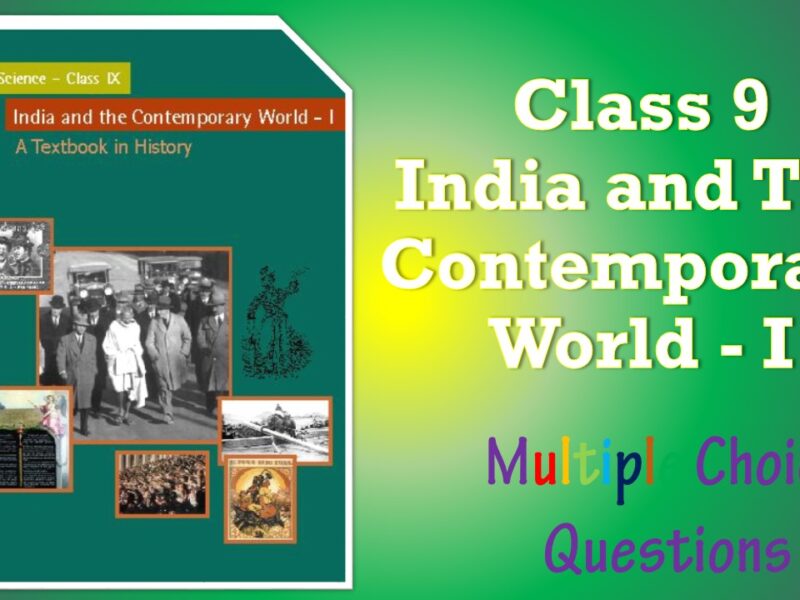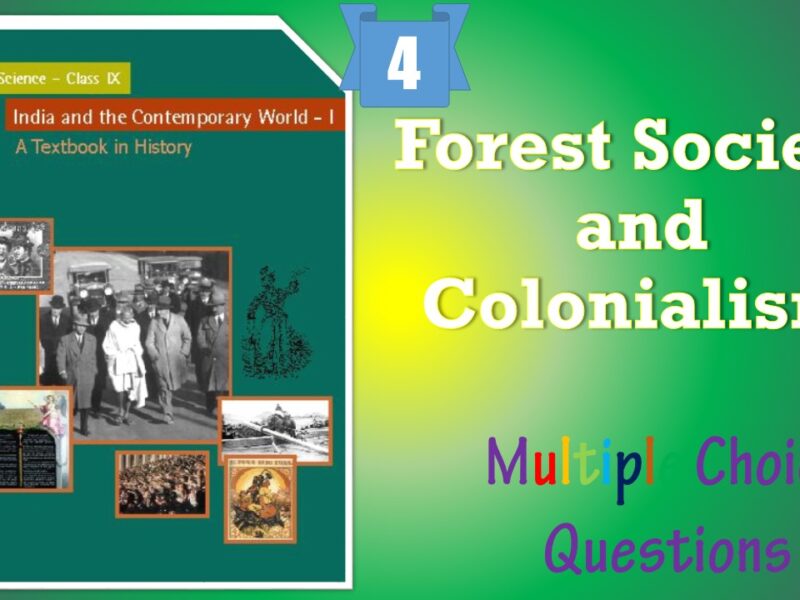Class 7 Social Science History MCQ Eighteenth-Century Political Formations with Answers is Prepared Based on Latest Exam Pattern. Students can solve NCERT Class 7 Social Science History MCQ Eighteenth-Century Political Formations with Answers to know their preparation level.
Students who are searching for NCERT Class 7 Social Science History MCQ Eighteenth-Century Political Formations with Answers are compiled here to get good practice on all fundamentals. Know your preparation level on MCQ Questions for Class 7 Social Science History MCQ Eighteenth-Century Political Formations with Answers. You can also verify your answers from the provided Class 7 Social Science History MCQ Eighteenth-Century Political Formations with Answers. So, ace up your preparation with MCQ of Class 7 Social Science History MCQ & NCERT Textbook solutions Examinations.
CBSE Class 7 Social Science History MCQ
Eighteenth-Century Political Formations
with Answers
Question : Who were the ijaradars?
(A) Revenue farmers
(B) Farmers
(C) Tax collectors
(D) All of these
Answer : (a) Revenue farmersShow Answer :
The state depended on local bankers and mahajans for loans. It sold the right to collect tax to the highest bidders. These “revenue farmers” (ijaradars) agreed to pay the state a fixed sum of money.
Question : What was the Jats were prosperous about?
(A) Artists
(B) Agriculturist
(C) Craftsman
(D) None of these
Answer : (b) AgriculturistShow Answer :
The Jats were prosperous agriculturists, and towns like Panipat and Ballabhgarh became important trading centres in the areas dominated by them.
Question : Who got the title of Asaf Jah founder of state of Hyderabad?
(A) Burhan-ul-Mulk
(B) Nizam-ul-Mulk
(C) Both (a) and (b)
(D) None of these
Answer : (b) Nizam-ul-MulkShow Answer :
Nizam-ul-Mulk Asaf Jah, the founder of Hyderabad state, was one of the most powerful members at the court of the Mughal Emperor Farrukh Siyar.
Question : Asaf Jah and Murshid Quli Khan held a zat rank of
(A) 7,000 each
(B) 6,000 each
(c) 9,000 each
(d) 8,000 each
Answer : AShow Answer :
Question : Aurangzeb died in the year
(A) 1700
(B) 1710
(C) 1725
(d) 1707
Answer : DShow Answer :
Question : Revenue farmers were called
(a) Jagirdar
(B) Ijaradars
(c) Nayak
(d) Subadar
Answer : BShow Answer :
Question : Under whose reign the banking house of Jagat Seth became extremely prosperous.
(A) Shah Alam II
(B) Alivardi khan
(c) Mir Jafar
(d) Nadir shah
Answer : BShow Answer :
Question : Dalkhalsa was set up in 1699 by
(A) Guru Nanak Singh
(B) Guru Tegh Bahadur
(c) Guru Gobind Singh
(d) Guru Har Kishan
Answer : CShow Answer :
Question : Who was given the subadari of Agra in 1722
(A) Raja Ajit Singh
(B) Raja Amrit Singh
(c) Raja Jai Singh
(d) Raja Amber Singh
Answer : CShow Answer :
Question : Shivaji adopted the title of Chhatrapati in
(A) 1701
(B) 1760
(C) 1752
(D) 1762
Answer : (d) 1762Show Answer :
Question : Tax levied by Marathas was called
(A) zat
(B) sardeshmukhi
(C) umara
(D) none of these
Answer : (b) sardeshmukhiShow Answer :
Question : Under whose leadership Bharatpur emerged as a strong Jat State?
(A) Churaman
(B) Suraj Mai
(C) Jawahir Shah
(D) Nadir Shah
Answer : (b) Suraj MaiShow Answer :
Question : Khalsa was found by:
(A) Guru Gobind Singh
(B) Guru Nanak
(c) Guru Arjun Dev
Answer : AShow Answer :
Question : During which century the Mughal Empire declined?
(A) 18th
(B) 16th
(c) 19th
(d) 21th
Answer : AShow Answer :
Question : During whose rule Jagat Seth became prosperous in Bengal?
(A) Murshil Quli
(B) Sa’adat Khan
(c) Alivardi Khan
(d) Asaf Jah
Answer : CShow Answer :
Question : The organisation of the Sikhs into a political community during the seventeenth century helped in regional state-building in the
(A) Punjab
(B) Awadh
(c) Bengal
(d) Jodhpur
Answer : AShow Answer :
Question : What was the Jats were prosperous about?
(A) Artists
(B) Agriculturist
(c) Craftsman
(d) None of these
Answer : BShow Answer :
Question : What was the total number of sikh misls before Ranjit Singh?
(a) 10
(B) 12
(c) 20
(d) 15
Answer : BShow Answer :
Question : Chauth was the ……….. of the land revenue.
(A) 10%
(B) 20%
(c) 25%
(d) 30%
Answer : CShow Answer :
Question : Murshid Quli Khan was Governor of:
(A) Bengal
(B) Awadh
(c) Hyderabad
Answer : AShow Answer :
Question : 9-10 per cent of the land revenue paid to the head revenue collector in the Deccan called
(A) Sardeshmukhi
(B) Dashemukh
(c) Deshmukhi
(d) Chuath
Answer : AShow Answer :
Question : Who controlled the offices of revenue and military administration
(A) Local people
(B) Britishers
(c) Governors
(d) King
Answer : CShow Answer :
Question : What were the offices held by Sa’adat Khan?
(a) Subadari
(B) Diwani
(c) Faujdari
(d) All of the above
Answer : DShow Answer :
Question : During which century the Mughal Empire declined?
(A) 18th
(B) 16th
(c) 19th
(d) 21th
Answer : AShow Answer :
Question : Why Mughals empire was facing problems closing of 17th century
(A) Britishers were under the control of Mughals
(B) Mughals military resources were very powerful
(c) Mughals successors left the Delhi
(d) Financial resources were depleted
Answer : DShow Answer :
Question : Aurangzeb had depleted the military and financial resources by fighting a long war in the
(A) East India
(B) North India
(c) Deccan
(d) none of these
Answer : CShow Answer :
Question : Bahadur Shah was the son of:
(A) Shah Jahan
(B) Akbar
(c) Aurangzeb
Answer : CShow Answer :
Question : Why did the Zamindars of Bengal borrow money from bankers and money lenders?
(A) To increase their wealth
(B) To pay revenue in cash
(c) To buy new land
(d) To promote the agricultures
Answer : BShow Answer :
Question : Nadir Shah was the ruler of which country?
(A) Iran
(B) Afghan
(C) Iraq
(D) None of these
Answer : (a) IranShow Answer :
In the midst of this economic and political crisis, the ruler of Iran, Nadir Shah, sacked and plundered the city of Delhi in 1739.
Question : What were the offices held by Sa’adat Khan?
(A) Subadari
(B) Diwani
(C) Faujdari
(D) All of the above
Answer : (d) All of the aboveShow Answer :
Sa’adat Khan held the combined offices of subadari, diwani and faujdari, In fact, he was responsible for managing the political, financial and military affairs of the province of Awadh.
Question : What were the jats prosperous in?
(A) Art
(B) Agriculture
(c) War
(d) Craft
Answer : BShow Answer :
Question : Kunbis were the:
(A) Maratha peasant warriors
(B) Maratha warriors
(C) Maratha farmers
Answer : (a) Maratha peasant warriorsShow Answer :
Question : Khalsa was instituted in the year:
(A) 1700
(B) 1699
(C) 1689
Answer : (b) 1699Show Answer :
Question : Sawai Raja Jai Singh found his new capital in:
(A) Jaipur
(B) Jodhpur
(C) Bikaner
Answer : (a) JaipurShow Answer :
Question : Which part of India associated with peasant and zamindari rebellions?
(A) Southern and eastern parts of India.
(B) Northern and southern parts of India.
(C) Northern and western parts of India.
Answer : (b) Northern and southern parts of India.Show Answer :
Question : Bahadur Shah was the son of:
(A) Shah Jahan
(B) Akbar
(C) Aurangzeb
Answer : (c) AurangzebShow Answer :
Question : Which part of India was associated with the peasant and zamindari rebellions?
(A) Southern and Eastern parts
(B) Northern and Southern parts
(c) Northern and western parts
(d) Eastern and Western parts
Answer : BShow Answer :
Question : Who was the founder of the Maratha empire?
(A) Shivaji
(B) Tipu Sultan
(c) Raja Jai Singh
(d) None of these
Answer : AShow Answer :
Question : Who was the founder of the Maratha Kingdom?
(A) Maharana Pratap
(B) Shivaji
(C) Raja Ajit Singh
Answer : (b) ShivajiShow Answer :
Question : Chauth was a tax:
(A) imposed by Maratha
(B) imposed by Mughals
(C) imposed by Peshwa
Answer : (a) imposed by MarathaShow Answer :
Question : Surajmal was a leader of:
(A) Maratha
(B) Jats
(C) Rajput
Answer : (b) JatsShow Answer :
Question : Murshid Quli Khan was Governor of:
(A) Bengal
(B) Awadh
(C) Hyderabad
Answer : (a) BengalShow Answer :
Question : Khalsa was found by:
(A) Guru Gobind Singh
(B) Guru Nanak
(C) Guru Arjun Dev
Answer : (a) Guru Gobind SinghShow Answer :
Question : Tax levied by Marathas was called
(A) zat
(B) sardeshmukhi
(c) umara
(d) none of these
Answer : BShow Answer :
Question : Telugu warrior chiefs were called
(A) Subadar
(B) Nayakas
(c) Mansabdar
(d) Faujdari
Answer : BShow Answer :
Question : What were the total number of Sikh misls before Ranjit Singh?
(A) Ten
(B) Twelve
(c) Twenty
(d) Fifteen
Answer : BShow Answer :
Question : What were the small political groups of the Sikhs called?
(A) Khalsa
(B) Misls
(C) Dalkhalsa
(D) None of these
Answer : (b) MislsShow Answer :
Under a number of able leaders in the eighteenth century, the Sikhs organized themselves into a number of bands called jathas, and later on misls.
Question : The British East India Company established its power after
(A) 1757
(B) 1761
(C) 1768
(D) 1771
Answer : (a) 1757Show Answer :
Question : Aurangzeb had depleted the military and financial resources by fighting a long war in the
(A) East India
(B) North India
(C) Deccan
(D) none of these
Answer : (c) DeccanShow Answer :
Question : Aurangzeb died in the year
(A) 1700
(B) 1710
(C) 1725
(D) 1707
Answer : (d) 1707Show Answer :
Question : Why did Zamindars of Bengal borrow money from bankers and moneylenders?
(A) To increase their wealth
(B) To pay revenue in cash
(C) To buy new land
(D) None of these
Answer : (b) To pay revenue in cashShow Answer :
Zamindars of Bengal borrow money from bankers and moneylenders to pay the revenue in cash.
Question : Who was the founder of Awadh?
(A) Saadat Khan
(B) Murshid Quli Khan
(C) Asaf Jah
(D) None of these
Answer : (a) Saadat KhanShow Answer :
Founder of Awadh was Burhan-ul-Mulk Saadat Khan.
Question : Who were appointed by Mughals to control over their provinces?
(A) Subadars
(B) Faujdari
(C) Diwani
(D) All of the above
Answer : (d) All of the aboveShow Answer :
Nobles appointed as governors (subadars) often controlled the offices of revenue and military administration (diwani and faujdari) to control their provinces.
Question : What were the total number of Sikh misls before Ranjit Singh?
(A) Ten
(B) Twelve
(C) Twenty
(D) Fifteen
Answer : (b) TwelveShow Answer :
There was total twenty Sikh misls before Ranjit Singh.
Question : Ahmad Shah Abdali was the ruler of
(A) Afghan
(B) Iran
(C) Iraq
(D) none of these
Answer : (a) AfghanShow Answer :
Question : During whose rule Jagat Seth became prosperous in Bengal?
(A) Murshil Quli
(B) Sa’adat Khan
(C) Alivardi Khan
(D) Asaf Jah
Answer : (c) Alivardi KhanShow Answer :
Question : Sawai Jai Singh founded his new capital here:
(A) Malwa
(B) Amber
(C) Jodhpur
(D) Jaipur
Answer : (d) JaipurShow Answer :
Question : Dalkhalsa was set up in 1699 by
(A) Guru Nanak Singh
(B) Guru Tegh Bahadur
(C) Guru Gobind Singh
(D) Guru Har Kishan
Answer : (c) Guru Gobind SinghShow Answer :
Question : Ahmad Shah Abdali invaded North India times between 1748 and 1761.
(A) 3
(B) 4
(C) 5
(D) 6
Answer : (c) 5Show Answer :
Question : During which century the Mughal Empire declined?
(A) 18th
(B) 16th
(C) 19th
(D) 21th
Answer : (a) 18thShow Answer :
Question : Which of the following enjoyed the zat rank of 7000?
(A) Asaf Jah
(B) Murshil Quli Khan
(C) Both of these
(D) None of these
Answer : (c) Both of theseShow Answer :
Question : Who were the Telugu warrior chiefs’?
(A) Nayakas
(B) Jathas
(C) Misl
(D) All of these
Answer : (a) NayakasShow Answer :
Question : Who was the powerful governor of Bengal?
(A) Sa’adat Khan
(B) Murshid Quli Khan
(C) Asaf Jah
(D) Alivardi Khan
Answer : (b) Murshid Quli KhanShow Answer :
Question : Small political groups of the Sikhs were called
(A) Khalsa
(B) Misls
(C) Dalkhalsa
(D) none of these
Answer : (b) MislsShow Answer :
Question : Chauth was the ……….. of the land revenue.
(A) 10%
(B) 20%
(C) 25%
(D) 30%
Answer : (c) 25%Show Answer :
Question : Who was the founder of Maratha empire?
(A) Shivaji
(B) Tipu Sultan
(C) Raja Jai Singh
(D) None of these
Answer : (a) ShivajiShow Answer :
Fill in the blanks with appropriate words.
Question : Guru Gobind Singh died in ……………. .
Answer : 1708Show Answer :
Question : 1/4th of the land revenue claimed by zamindars was known as ……………. .
Answer : ChauthShow Answer :
Question : Revenue in Bengal was collected in ……………
Answer : cashShow Answer :
Question : Chief Minister of Marathas was called ……………..
Answer : PeshwaShow Answer :
Question : Sawai Raja Jai Singh was given subadari of ……………. in the year 1722.
Answer : AgraShow Answer :
Question : Hyderabad was founded by ……………. .
Answer : Asaf JahShow Answer :
Question : Ahmad Shah Abdali came to India in ……………. .
Answer : 1759Show Answer :
Question : A revenue farmer was called ……………. .
Answer : IjaradarShow Answer :
Question : Guru Gobind Singh is ……………. guru of Sikh.
Answer : 10thShow Answer :
Question : Third battle of Panipat (1761) was fought between Marathas and ………….
Answer : Ahmad Shah AbdaliShow Answer :
Question : Bengal was founded by ……………. .
Answer : Murshid Quli KhanShow Answer :
Question : Maharaja Ranjit Singh established his capital at ……………. .
Answer : LahoreShow Answer :
Question : Shivaji carried out the ……………. kingdom.
Answer : MarathaShow Answer :
Question : Ruler of Iran ………… plundered the city of Delhi in 1739.
Answer : Nadir ShahShow Answer :
Question : Mughal nobles were divided in two factions, the ………….. and the …………..
Answer : Iranis, TuranisShow Answer :
Question : System of rakhi offered protection to cultivators on payment of a tax of ……………. of produce.
Answer : 20%Show Answer :
State whether the given statements are true or false.
Question : Banking house of Jagat Seth became extremely prosperous during the rule of Murshid Quli Khan.
Answer : FalseShow Answer :
Question : Khalsa was instituted in 1699.
Answer : TrueShow Answer :
Question : Nobles appointed as Governors by the Mughals had no control over Diwani and Faujdari.
Answer : FalseShow Answer :
Question : Ahmad Shah Abdali invaded north India 5 times between 1748-1761.
Answer : TrueShow Answer :
Question : Ranjit Singh was an important leader of Marathas.
Answer : FalseShow Answer :
Question : Jats consolidated their power under the leadership of Churaman.
Answer : TrueShow Answer :




